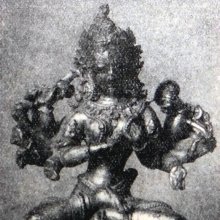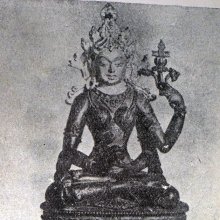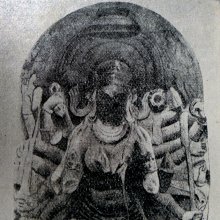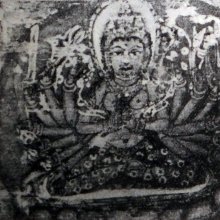Ashtabhujakurukulla, Aṣṭabhujakurukullā, Ashtabhuja-kurukulla: 1 definition
Introduction:
Ashtabhujakurukulla means something in Buddhism, Pali. If you want to know the exact meaning, history, etymology or English translation of this term then check out the descriptions on this page. Add your comment or reference to a book if you want to contribute to this summary article.
The Sanskrit term Aṣṭabhujakurukullā can be transliterated into English as Astabhujakurukulla or Ashtabhujakurukulla, using the IAST transliteration scheme (?).
Images (photo gallery)
In Buddhism
Tibetan Buddhism (Vajrayana or tantric Buddhism)
Source: archive.org: The Indian Buddhist IconographyAṣṭabhujakurukullā (अष्टभुजकुरुकुल्ला) refers to one of the names of Kurukullā: one of the various (female) emanations of Amitābha having their Sādhana described in the 5th-century Sādhanamālā (a collection of sādhana texts that contain detailed instructions for rituals).—Her Colour is red; her Āsana is the vajraparyaṅka; her Mudrā is the trailokyavijaya; she has eight arms
Uḍḍiyānakurukullā [according to the information supplied by the sādhanas], is not terrible like the six-armed Māyājāla Kurukullā or the four-armed Uḍḍiyanā Kurukullā, but is mild, youthful and compassionate The most important feature of the Sādhana us that it gives the description of a complete Maṇḍala which comprises the principal goddess and twelve surrounding divinities.
The Dhyāna (meditation instructions) of Vajradharma described in the Sādhanamālā as follows:
“The worshipper should think himself as goddess Kurukullā, who is eight-armed, red in colour, sits in the vajraparyaṅka attitude, on the orb of the sun over the lotus with eight petals and resides in the sanctum; she displays the trailokyavijayamudrā in her first pair of hands, and shows in the other right hands, aṅkuśa, the arrow drawn up to the ear and the varada pose, In the remaining left hands she holds the noose, the bow and the utpala; she is decked in all kinds of ornaments.
On the east petal is Prasannatārā, on the south is Niṣpannatārā, on the west Jayatārā, on the north Karṇatārā; on the north-east petal is Cundā, on the east Aparājitā, on the south-west Pradīpatārā, and on the north-west is Gaurītārā. All these deities have red colour and the five Dhyāni Buddhas on their crowns. They sit in the vajraparyaṅka attitude and show in the two right hands the boon and the arrow drawn up to the ear, and in the two left hands the utpala and the bow.
In the eastern gate is Vajravetālī, who has a protruding belly, distorted face, red complexion, the effigy of Akṣobhya on her crown, and carries in the two right hands the Tarjanī and the goad, and in the two left the Vajraghaṇṭā and the noose.
In the southern gate is Aparājitā, who is yellow in colour and has the effigy of Ratnasambhava on her crown; she carries in her two right hands the staff and the goad, and in the two left the bell and the noose.
In the western gate is Ekajaṭā, who is blue in colour with hair rising upwards over head, and a protruding belly; she bites her lips with her teeth, bears the image of Amitābha on her crown and carries in her two right hands the vajra and the goad, and in the two left the bell and the noose.
In the northern gate is Vajragāndhārī, golden in complexion, whobears the image of Amoghasiddhi on her crown, has a distorted face and portruding belly, and carries in her two right hands the sword and the goad, and in the two left the bell and the noose.
All these four goddesses stand in the ālīḍha attitude
[This Sādhana is attributted in the colophon to the great Siddhācārya Indrabhūti, who flourished about 700 A.D. and who had a daughter even more illustrious than himself, Lakṣmīṅkarā by name, well-versed in the doctrines of both Vajrayāna and Sahajayāna.]

Tibetan Buddhism includes schools such as Nyingma, Kadampa, Kagyu and Gelug. Their primary canon of literature is divided in two broad categories: The Kangyur, which consists of Buddha’s words, and the Tengyur, which includes commentaries from various sources. Esotericism and tantra techniques (vajrayāna) are collected indepently.
See also (Relevant definitions)
Partial matches: Ashtabhuja, Kurukulla.
Full-text: Kurukulla.
Relevant text
Search found 1 books and stories containing Ashtabhujakurukulla, Aṣṭabhujakurukullā, Ashtabhuja-kurukulla, Aṣṭabhuja-kurukullā, Astabhuja-kurukulla, Astabhujakurukulla; (plurals include: Ashtabhujakurukullas, Aṣṭabhujakurukullās, kurukullas, kurukullās, Astabhujakurukullas). You can also click to the full overview containing English textual excerpts. Below are direct links for the most relevant articles:
The Indian Buddhist Iconography (by Benoytosh Bhattachacharyya)



